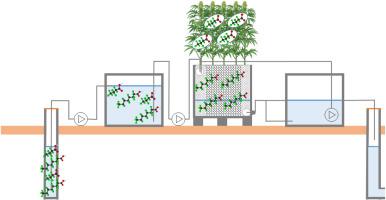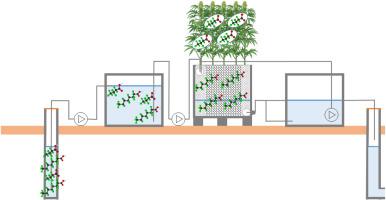Pilot scale treatment of PFAS-contaminated groundwater in a subsurface flow constructed wetland–evaluating multiple plant species
IF 7.3
2区 环境科学与生态学
Q1 ENVIRONMENTAL SCIENCES
引用次数: 0
Abstract
Groundwater contamination by per- and polyfluoroalkyl substances (PFAS) is an emerging threat to drinking water quality, highlighting the need for effective treatment solutions. This study investigated subsurface flow constructed wetlands for treating groundwater contaminated with PFAS. The wetlands used a peat, biochar, and lightweight expanded clay aggregate (LECA) filter substrate, planted with either tufted sedge (Carex elata), fiber hemp (Cannabis sativa Futura 75), or an intercropping of the two Salix clones S. Wilhelm and S. Loden. The experiment was conducted under field conditions in Sweden, during one growing season, using PFAS-contaminated groundwater impacted by landfill leachate. The study showed accumulation of PFAS in all plant species and the peat and biochar part of the filter substrate, with short-chain PFAS and perfluoroalkyl carboxylates (PFCAs) dominating when considering the whole plants (57 % and 77 % of ƩPFAS, respectively) and long-chain PFAS and perfluoroalkyl sulfonates (PFSAs) dominating in the peat and biochar filter substrate (77 % and 54 % of ƩPFAS, respectively). Sorption to the filter substrate was shown to be the primary mechanism for PFAS removal. The highest plant PFAS concentrations were found in leaves, followed by roots, for all species. There was a difference in the PFAS composition profile when comparing different plant tissues, with PFCAs dominating in leaves (84 % of ƩPFAS) and PFSAs dominating in roots (66 % of ƩPFAS). All plant species were determined to have an above-ground tissue/water phase concentrations >10/1 for C3-PFCA (PFBA). This was also observed for C. sativa with C4- and C7-PFCAs (PFPeA, PFOA), and C4- and C5-PFSAs (PFBS, PFPeS), for C. elata with C8-PFSA (L-PFOS), and for S. Loden with PFPeA. ∑PFAS phytoextraction potential from landfill leachate-impacted groundwater (mg/ha yr) was estimated to be 940 ± 670 for C. sativa, 390 ± 310 for S. Loden, 330 ± 160 for S. Wilhelm, and 160 ± 56 for C. elata.


地下流人工湿地中pfas污染地下水的中试处理——对多种植物种类的评价
全氟烷基和多氟烷基物质对地下水的污染是对饮用水质量的新威胁,突出表明需要有效的处理办法。研究了处理PFAS污染地下水的地下流人工湿地。该湿地使用泥炭、生物炭和轻质膨胀粘土集料(LECA)过滤基质,种植有丛生莎草(Carex elata)、纤维大麻(Cannabis sativa Futura 75),或两种柳属无性系S. Wilhelm和S. Loden的间作。该试验是在瑞典一个生长季节的野外条件下进行的,使用的是受垃圾填埋场渗滤液影响的pfas污染的地下水。研究表明,PFAS在所有植物物种以及过滤底物的泥炭和生物炭部分都有积累,从整个植物来看,短链PFAS和全氟烷基羧酸盐(PFCAs)占主导地位(分别占ƩPFAS的57%和77%),而长链PFAS和全氟烷基磺酸盐(PFSAs)在泥炭和生物炭过滤底物中占主导地位(分别占ƩPFAS的77%和54%)。对过滤底物的吸附被证明是去除PFAS的主要机制。在所有物种中,植物PFAS浓度最高的是叶片,其次是根。在比较不同的植物组织时,PFAS的组成存在差异,PFCAs在叶片中占主导地位(ƩPFAS占84%),PFSAs在根中占主导地位(ƩPFAS占66%)。所有植物的地上组织/水相中C3-PFCA (PFBA)的浓度均为10/1。这也被观察到C4-和C7-PFCAs (PFPeA, PFOA), C4-和C5-PFSAs (PFBS, PFPeS), C8-PFSA (L-PFOS)的C. elata,以及PFPeA的S. Loden。从受垃圾渗滤液影响的地下水中提取的∑PFAS电位(mg/ha yr)分别为:苜蓿(C. sativa) 940±670 mg/ha yr,黄草(S. Loden) 390±310 mg/ha yr,黄草(S. Wilhelm) 330±160 mg/ha yr,黄草(C. elata) 160±56 mg/ha yr。
本文章由计算机程序翻译,如有差异,请以英文原文为准。
求助全文
约1分钟内获得全文
求助全文
来源期刊

Environmental Pollution
环境科学-环境科学
CiteScore
16.00
自引率
6.70%
发文量
2082
审稿时长
2.9 months
期刊介绍:
Environmental Pollution is an international peer-reviewed journal that publishes high-quality research papers and review articles covering all aspects of environmental pollution and its impacts on ecosystems and human health.
Subject areas include, but are not limited to:
• Sources and occurrences of pollutants that are clearly defined and measured in environmental compartments, food and food-related items, and human bodies;
• Interlinks between contaminant exposure and biological, ecological, and human health effects, including those of climate change;
• Contaminants of emerging concerns (including but not limited to antibiotic resistant microorganisms or genes, microplastics/nanoplastics, electronic wastes, light, and noise) and/or their biological, ecological, or human health effects;
• Laboratory and field studies on the remediation/mitigation of environmental pollution via new techniques and with clear links to biological, ecological, or human health effects;
• Modeling of pollution processes, patterns, or trends that is of clear environmental and/or human health interest;
• New techniques that measure and examine environmental occurrences, transport, behavior, and effects of pollutants within the environment or the laboratory, provided that they can be clearly used to address problems within regional or global environmental compartments.
 求助内容:
求助内容: 应助结果提醒方式:
应助结果提醒方式:


